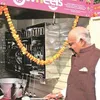This 19-year-old has developed a low-cost, non-invasive method to detect malnutrition in children
Mohammed Suhail, a Class XII dropout, has been awarded the Pradhan Mantri Rashtriya Bal Puraskar by President Ram Nath Kovind for his work on detecting malnutrition
At a time when most youngsters were busy in making a career choice or hustling around to get admissions in good colleges, 19-year-old Mohammed Suhail CS was spending his time for a larger cause.
Suhail’s inquisitiveness and quest for the uncharted led him to develop a paper-based non-invasive method to diagnose malnutrition using just a piece of paper. In 2019, he was awarded the prestigious Pradhan Mantri Rashtriya Bal Puraskar by the Hon'ble President of India, Ram Nath Kovind, for his work.

Suhail being awarded the Pradhan Mantri Rashtriya Bal Puraskar.
Born in the port city of Mangalore, Karnataka, Suhail’s childhood was both happy and enriching. Instead of going to school and attending classes, he would stay back at home to read books and conduct experiments. However, at no point in time he let it affect his grades. Suhail’s keen interest in STEM (Science, Technology, Engineering, Mathematics) drove him to participate in a slew of fairs and competitions, both at the state and national levels.
However, the lad’s tryst with diagnostics began in 2016 when he and his friend Swastik Padma heard the TED talk of Manu Prakash, a Professor of Bioengineering at Stanford University, on life-saving diagnostic tools using paper.
The same year, Suhail and Swastik came across the Intel International Science and Engineering Fair (ISEF), one of the world’s largest international pre-college science competitions, and decided to take part in it.
From thereon, there was no looking back.
“During the course of my study, I found a report by the WHO that said - around 45 percent of deaths among children is linked to undernutrition across the globe. When I looked into the diagnostic developments in the space, I got to know that there was an absence of quantitative methods. So, without thinking twice, I started working with Swastik in that direction and spent many months testing and scrutinising various processes. It sure was a tough grind, but we kept at it,” Suhail tells SocialStory.
A journey filled with ups and downs
Since Suhail believed in learning on the job and acquiring knowledge in different subjects, he avoided attending classes. Instead, he spent time on reading and research, and appeared only for exams. The 13-year-old jumped four schools between grade VII to XI.

19-year-old Mohammed Suhail.
“I had to put up with a whole lot of criticism and naysayers at that time. Everyone was against me not going to school. They thought I was ruining my life. There was a phase where I was completely depressed too! Luckily, my parents were supportive and understanding,” Suhail says.
In 2018, yet again, Suhail was in a position where he had to choose between participating in ISEF and clearing grade XII from St. Aloysius PU College, Mangalore, and he ended up going to the latter.
Presently, Suhail has taken to homeschooling with tools like Khan Academy, online tutorials, and textbooks, and is waiting to hear from Massachusetts Institute of Technology (MIT), where he has applied for an undergrauate programme in Bioengineering.
Finding a solution to the malnutrition problem
For many years now, blood test has been the only sure way to identify malnutrition and in-ground tools like BMI index charts, arm-circumference scales are used to understand it qualitatively. Suhail’s idea behind finding a quantitative method to detect malnutrition in children was to help in the process of treating the condition by introducing the right interventions and more personalised meals.
“When we kicked off our research, our objective was to find a non-invasive (without the use of any invasive methods) way to detect the amount of protein as well as the enzyme activity within the body. We tried drawing samples of sweat, nails, and even skin to conduct the tests. But, all of these failed and we had to begin all over again,” says Suhail.

Mohammed Suhail delivering a TEDx talk.
Finally, Suhail tried using saliva as the base. The magic happened when he performed the starch-iodine test using paper strips with saliva. He observed that the colour of the spittle changed every time a new sample was taken due to enzymic activity in the protein. Using AutoML feature, Suhail then developed a way in which the protein levels in a person’s body can be predicted based on the colour change of the starch-iodine-saliva. The entire cost of this test costs only Rs 2 (simulated), and can be administered with ease.
For his innovation, Suhail won ISEF’s second global grand award in the translational medical science category in 2018.
“That was one of the best days of my life. My joy knew no bounds. Giving up my grade XII exams seemed worth it after all,” he recollects.
An inspiration for many
According to the World Health Organisation, 52 million children under the age of five years are wasted, or low weight for height, and 155 million of them are stunted.
Suhail says, he wanted to contribute towards improving this scenario.
“Governments of various developing countries have been executing several strategies to tackle it. But the same standard diet is recommended for all the undernourished children immaterial of the extent of malnutrition in their body. This might not yield the desired results,” he says.
Since the 19-year-old’s invention enables people to determine the level of protein in children’s bodies, more customised diets can be given out and precise interventions implemented. Suhail's methods have still not been implemented at large, but he is looking forward to work with the government in the future.
Right from dropping grade XII and putting up with nasty comments from acquaintances to spending hours doing research, Suhail has done it all. His unwavering attitude and diligence are serving as an inspiration for many.
(Edited by Megha Reddy)









